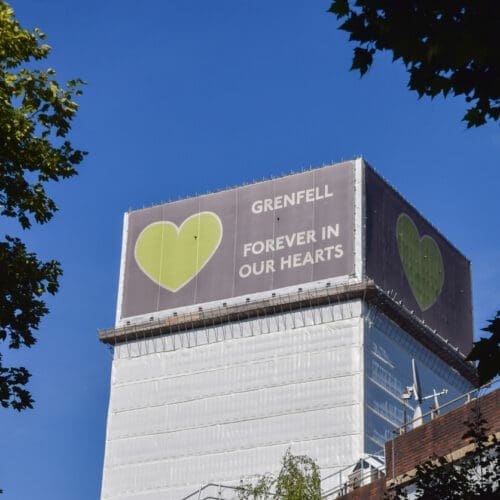GRENFELL TOWER INQUIRY: PHASE 2 REPORT – Summary of main findings
September 2024Introduction
On 4 September 2024, the Grenfell Tower Inquiry published its highly anticipated Phase 2 Report into the fire at Grenfell Tower on 14 June 2017 (the “Report”)[1]. At the centre of this is the significant human tragedy – the fire resulted in 72 deaths, injuring and impacting many others. The Public Inquiry’s Phase 1 report, detailing the events on the night of the fire and comprising over 850 pages across four volumes, was published in late October 2019.
Seven years on from the fire, the voluminous Phase 2 Report follows consideration of substantial evidence and testimonies and examines the circumstances as well as the underlying root causes contributing to the tragedy. The Inquiry’s Terms of Reference, the impact of the pandemic in halting and delaying evidence sessions, and the sheer scale and scope of evidence presented meant that the Report took longer to conclude than initially anticipated. However, it represents another important milestone for the victims and their relatives, as well as a significant step in building a safer future.
Key Takeaways from the Report
Volume 1, Part 1 (Introduction and Executive Summary) and Volume 7, Part 14 (Recommendations) provide an overview of the Report’s core findings. Although the Report is broken down into the numerous and important wider issues, our update summarises the key parts of relevance to our clients and the construction industry, including the core conclusions reached, recommendations and potential impacts for those professionals and stakeholders operating in this space.
The Report:
- Concludes that the deaths were avoidable, and the Tower’s residents were failed by those who should have helped to ensure their safety.
- Criticises multiple entities and individuals connected with the Tower’s management and refurbishment, highlighting various decisions and errors – ranging from incompetence to dishonesty and illegality – amounting to systemic and organisational failure. The entities criticised include the government, the local authority (and its building control function), the Tenant Management Organisation (“TMO”), the London Fire Brigade, the manufacturers, suppliers and certifiers of materials including the British Board of Agrément (“BBA”), construction parties, and industry bodies such as the Building Research Establishment and the National House Building Council.
- Considers progress made to enhance building and fire safety and further change required.
- Presents 19 pages of recommendations aiming to avoid a further tragedy, addressing central and local government, fire and rescue services and the wider construction industry.
Core Findings in the Report
- Government: Although various government departments received warnings concerning combustible panels and insulation from about 1991, there was a failure to give proper consideration to the danger of using and incorporating such materials in high rise buildings (“HRBs”); misunderstanding that regulation was effective; and failure to amend the applicable guidance. According to parts of the Report, departments displayed a complacent, defensive or dismissive attitude to fire safety matters.
- Regulatory context: This was unsatisfactory, particularly in respect of the industry’s regard to compliance with the relevant guidance (as well as the guidance not being clear enough about the need for compliance with the Building Regulations).
- Architect: The appointment of the architect without going through competitive public procurement (because they were already appointed as architect on another project) was viewed by the TMO as beneficial at the time. However, this had serious consequences including due to the architect’s lack of experience of working on high rise overcladding projects. Its failure to recognise that the products to be used were unsuitable/dangerous and to warn against their use also represented a failure to act in accordance with the applicable standard of care and in line with statutory guidance. Criticisms were also made since the architect failed to understand its responsibility for its design work, and, in its capacity as Lead Designer, work carried out by sub-contractors, and did not check relevant designs. It did not devise a proper cavity barrier strategy, produce detailed drawings of the window reveals, or notice that the materials specified for the window infill panels were unsuitable.
- Contractor and sub-contractor: The principal contractor and sub-contractor failed to fully comprehend the choice of materials (and who was responsible for the same). The Report notes that the Design and Build Contractor used an inexperienced team, gave inadequate thought to fire safety, displayed a casual attitude and its systems for managing design work did not ensure that its sub-contractors/consultants were competent and properly understood their responsibilities. The contractor did not understand where responsibility for decisions lay and failed to co-ordinate the design work properly. The sub-contractor failed to ask about the materials being considered and appeared to be induced to buy products partly by its existing relationships.
- The relevant construction parties: Were criticised for failing to clearly identify responsibilities for important aspects of the design and assumed someone else was responsible for matters affecting fire safety. The Report infers an unacceptably casual approach towards contractual arrangements and responsibilities and a pervasive trend of evading responsibility by continually shifting the blame (see the ‘web’ of blame produced following earlier stages of the Inquiry). Further, core project documents were left in draft or were incomplete, such as the fire safety strategy for the building in its refurbished form.
- Building control: This was compounded since the design or choice of materials was not scrutinised and building control failed to confirm that the completed work would comply with Building Regulations. The building control surveyor was inadequately trained, overworked, and had limited understanding of the risks of such panels. The surveyor failed to obtain full information on the construction and enquire about the completed fire safety strategy. Additionally, the Report highlights the tension between the regulatory function of building control, and the conflicting commercial interests or pressures that prevented a system that effectively served the public interest.
- Manufacturers: The Panel also found systematic inadequacies and dishonesty, for example with the deliberate manipulation of test data, provision of information, and in the marketing of products which were unsuitable for use in the external walls of HRBs. This dishonesty was compounded by the failure of certifying bodies to scrutinise the information and wording provided to them about these products and to enforce processes and contracts robustly.
- TMO: The TMO, and its relationship with the residents, was key. It was poorly run and failed to respond to residents’ requests and the recommendations made in an independent report in 2009. The antagonistic and deteriorating relationship was characterised by mistrust and the Panel deemed that the TMO failed to carry out its basic fire safety responsibilities. The Panel specifically highlighted issues with the management and importance placed on fire safety matters, considering that residents were badly let down particularly in relation to the safety of vulnerable people. The TMO’s CEO failed to keep the board properly updated and informed about fire safety concerns despite issues and notices drawn to its attention.
- Further the TMO’s failings were illustrated by its reliance on fire risk assessments across its estate portfolio by one individual who was unqualified to carry these out, failures to carry out remedial works to defects and fire safety measures, and adequately record and maintain information on vulnerable people who might need assistance in evacuating in an emergency. The TMO also failed to take sufficient care choosing the architect and paid insufficient attention to fire safety matters, including the fire engineer’s work.
- Generally: Throughout the construction industry, including product manufacturers and installers, companies had a lack of understanding or awareness and appeared to take advantage of a flawed and ineffective regulatory system to attract or retain customers, cut costs, and boost commercial drivers and profits. There effectively appeared to be a presumption that Building Regulations and building control processes were effective, construction products underwent appropriate testing and marketing, and that designers and contractors were fully competent and aware of their roles.
Relevant Recommendations
The Panel believe that consideration and implementation of its recommendations will increase fire safety, particularly for HRBs, and lead to efficiencies in the construction industry and fire and rescue services.
The Report acknowledges that the safety of people in the built environment depends principally on a combination of good design, choice of suitable materials and sound methods of construction, each of which also rely on the skill, knowledge and experience of those engaged in the construction industry. The Inquiry’s investigations unfortunately revealed serious deficiencies in all those areas.
As a result, the main recommendations to note include:
- Establishing a single construction regulator (person) to oversee all aspects of the construction industry and inform government of developments or changes to such requirements. The regulator’s role would involve driving change in industry culture; promoting and exchanging of information or ideas across industry (both in the UK and abroad); certifying construction products; and licensing contractors for HRBs, amongst other functions currently discharged by one or various bodies.
- The Secretary of State appointing a Chief Construction Adviser with good working knowledge and practical experience of the construction industry.
- Consolidating fragmented government fire safety responsibilities into one department so proper regulatory oversight can be given and efficiencies gained.
- Reviewing and amending the current law as necessary given the Report’s conclusions and recommendations (including a potential widening of the definition of HRBs, since the reference to the height of the building is deemed unsatisfactory and arbitrary in nature).
- Clarifying and updating the Approved Documents and statutory guidance accompanying Building Regulations, primarily driven by safety concerns and with appropriate review and input from representatives from academia and those with practical industry experience chosen for experience and skill.
- New statutory requirements for certain documentation or statements to be produced in support of the relevant building control applications and at Gateways 2 or 3. For example, a fire safety strategy produced by a registered fire engineer; and appropriate statements from the principal designer and principal contractor confirming that all reasonable steps have been taken to ensure that the building will be safe on completion.
- A review and development of new test methods to provide reliable assessments and information, with the construction regulator responsible for assessing the conformity of construction products with the requirements of legislation, statutory guidance and industry standards and certifying as appropriate.
- A professional fire engineering body with regulation, including on title, qualifications and conduct. Coupled with the acceleration of an objective authoritative statement of the skills a fire engineer should be expected to possess, i.e. from a practical, scientific and intellectual perspective, and the number of places on high-quality fire engineering courses to help improve competence and promote effective communication overall.
- Whilst the Report acknowledges that the Architects Registration Board and the Royal Institute of British Architects have taken steps to improve the education and training of architects, these should be reviewed to ensure they are sufficient in light of findings.
- Licencing scheme for contractors on HRBs and mandatory accreditation system for fire risk assessors.
- The creation and maintenance of a public record of recommendations and steps taken in response to feedback from public inquiries, coroners, and select committees.
- Creation of a construction library with key information including product and test data.
- Evaluating building control functions including whether these should be performed by parties with a commercial interest, or possibly by a national authority.
- Appropriate and regular training for fire and rescue services.
Concluding Commentary
The comprehensive Report has already received widespread attention across the UK and the construction industry and is likely to inform the approach to building and fire safety taken in other jurisdictions in the future.
The Report will interest legal practitioners and construction professionals since it will impact future change within the construction industry (including cultural, legislative, regulatory and technological change). It notes that Section 2(1) of the Inquiries Act 2005 expressly prohibits the Panel from ruling on questions of legal liability, civil or criminal – that is a matter for courts. However, Section 2(2) provides that it is not to be inhibited in the discharge of its functions by any likelihood of liability being inferred from any facts found or recommendations made, and so it may be persuasive for future procurements and negotiations of construction contracts or on the future claims or prosecutions. The Report’s suggestions are also expected to shape further government policy on fire and building safety in England and Wales, akin to the influence of the earlier Hackitt Report after the tragedy in 2018. In light of recent fires reported, including within the London area, the Report may also lead to the review and acceleration of remedial works to other affected HRBs.
Notwithstanding the impact of the earlier reforms, the Report unequivocally indicates that these are insufficient. According to the recommendations, there is a pressing need for more comprehensive regulation of the construction industry and fire safety professions, and in terms of overhauling the industry’s culture. Ensuring building and fire safety must remain the top priority for all involved in designing, constructing, maintaining, and managing buildings.
If you require support on any of the issues raised by the Report or its recommendations, please contact the authors. You can also find out more about building safety via our website and forthcoming series of resources covering some of the main themes.
[1] Publication of the Grenfell Tower Inquiry phase 2 report – GOV.UK (www.gov.uk)
[2] GRENFELL TOWER INQUIRY: PHASE 2 REPORT – REPORT of the PUBLIC INQUIRY into the FIRE at GRENFELL TOWER on 14 JUNE 2017, Volume 1, paragraph 1.14 (4 September 2024).
Download PDF









